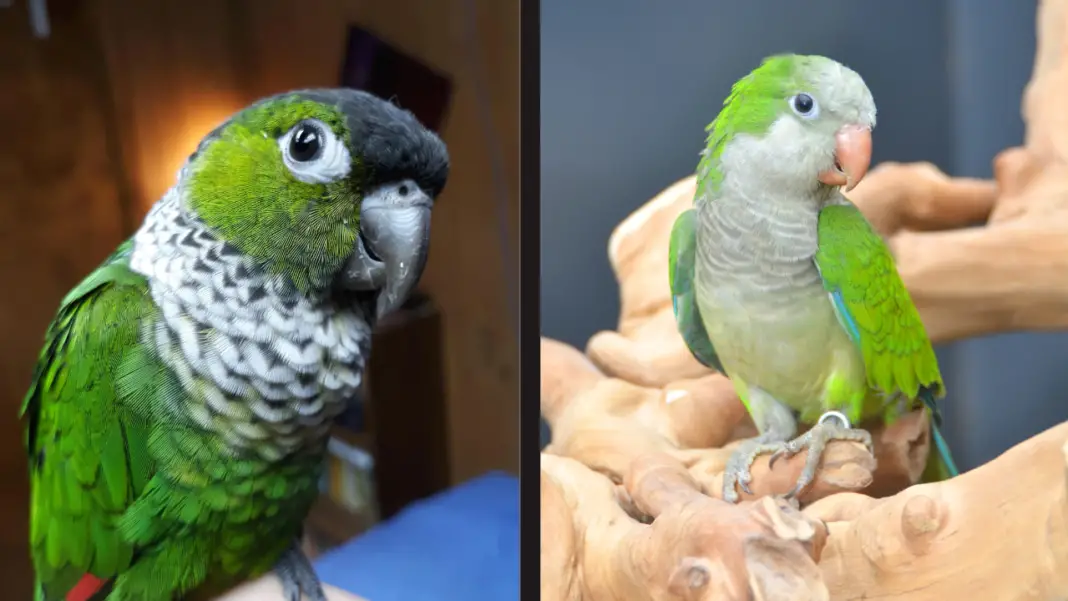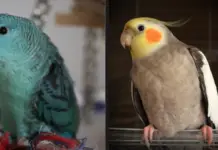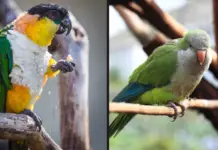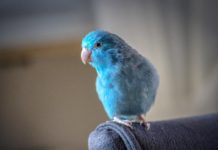If you’re trying to pick the right parrot species to add to your family, you may be stuck between choosing a green cheek conure or a quaker parrot. Understandable: given that both are popular birds that can make wonderful pets.
If you’re not sure which bird to choose, keep reading! We’ll discuss the green cheek conure vs quaker parrot differences, similarities and which species may be better for you.
Green Cheek Conure Vs Quaker Parrot: Differences
If you’re having trouble choosing between a green cheek conure and a quaker parrot, it’s not surprising given that they’re both very popular. In many respects, they’re actually not that similar at all. Luckily, this actually makes it easier to choose between the two birds.
Let’s have a look at some of the main differences between a green cheek conure and a quaker parrot.
The Species
Taxonomy – green cheek conures are a small parrot species “Pyrrhura” and are primarily green with a grey barring on their chest. “Quaker parrot” is a non-scientific term used to describe “Myiopsitta monachus”, sometimes referred to as “monk parrot”. Similar to the green cheek conure, they have vivid green on the head, wings, and back, with a grey chest.
Size
The green cheek conure on average is 10 inches long, while the quaker parrot a little bigger at around 12 inches long.
Habitat
Green cheek conures can be found in the wilds in Brazil, Bolivia, Argentina and Paraguay, where they inhabit forests and woodland areas. Like the green cheek conure, the quaker parrot can be found in small areas within South America, which includes central Bolivia and southern Brazil into parts of central Argentina.
Lifespan
Both green cheek conures and quaker parrot species can live for upwards of 30 years in exceptional cases, although 20 years is more common.
Activity Level
In the wild, green cheek conures fly long distances while searching for food, mate, or nesting site. While that’s not possible, when they’re in captivity, they need to be able to leave the cage and exercise for at least 2 hours daily to remain happy and healthy.
They may require a play gym on the top of their cage where they can spread their wings and exercise.
Like the green cheek conure, quaker parrots are a playful and energetic bird. They need lots of toys in and out of their cage. It’s recommended to let quaker parrots out for around 2 hours every day.
Affection Levels
Although both species can be affectionate, bird enthusiasts report that green cheek consures tend to be cuddlier, although the difference between the two birds isn’t big when it comes to being cuddly.
Trainability
Although both species are very intelligent and can easily learn new tricks, green cheek conures seem to be more trainable. They seem to have a little more enthusiasm!
Allergies
The good news is that both green cheek conures and quaker parrots are hypoallergenic, meaning they don’t give off dander or dust. So, if you’re someone that loves birds but are cautious, then either of these birds would be suitable.
Who Is A Green Cheek Conure Better For?
This mostly comes down to the activity level you’re looking for in a bird. You’ll love a green cheek conure if you’re looking for a cheerful friend that can make you laugh with its antics and if you have the patience and time to train your bird, then the green cheek conure may be for you.
Like quaker parrots, green cheek conures can be very cuddly birds, but they can also be curious and bold. It’s a joy to spend time with a green cheek conure, as you can introduce it to fun new toys and sharing the hustle and bustle of a busy household with it.
Who Is A Quaker Parrot Better For?
As far as parrots go, Quaker Parrot are very relaxed birds. They love to play, although they can be very loud.
One potential downside with having a quaker parrot is that they can be known to be very protective of their cage and food bowls, although if you can spend enough time with them, you should be able to solve this problem.
Conclusion
Hopefully, this article has given you an idea of which bird will better suit you. It’s still a good idea to research some more before making a decision. After all, getting a pet bird is a big commitment for many years to come!








